Another big week, with twelve Secret Wars tie-ins (including four debuts), a bunch of second issues involving last month’s DC relaunches, and other interesting stuff, including the final Matt Fraction/David Aja Hawkeye, a new Kieron Gillen sf book, and new issues of Lumberjanes, Justice League, Trees, Groo and Usagi Yojimbo: all perfect for summertime reading. Adjust the hammock, put another ice cube in the lemonade, and let’s get started…
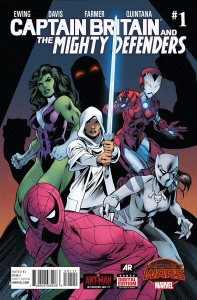 Secret Wars: Captain Britain and the Mighty Defenders #1 (of 2) — Writer: Al Ewing; Pencils: Alan Davis; Inks: Mark Farmer; Colors: Wil Quintana
Secret Wars: Captain Britain and the Mighty Defenders #1 (of 2) — Writer: Al Ewing; Pencils: Alan Davis; Inks: Mark Farmer; Colors: Wil Quintana
Secret Wars: Guardians of Knowhere #1 (of 4) — Writer: Brian Michael Bendis; Art: Mike Deodato; Colors: Frank Martin
Secret Wars: Hail Hydra #1 (of 3) — Writer: Rick Remender; Art: Roland Boschi; Colors: Chris Chuckry
Secret Wars: Siege #1 (of 3) — Writer: Kieron Gillen; Art: Felipe Andrade; Double-Page Spreads: Andrade and Rosenberg; James Stokoe; Jorge Coelho; Colors: Rachelle Rosenberg
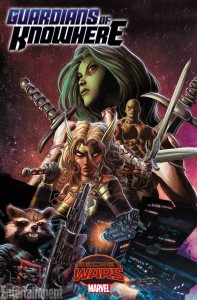 These are all of the Secret Wars first issues for the week; Captain Britain and the Mighty Defenders makes a lot of use of the alternate-timelines ideas, including a world where, during his origin, Tony Stark gave his newly-built armor to Dr. Yinsen, his cellmate, and then died, and the Peter Parker Spider-Man was killed by Morlun, leaving Hobie Brown, the former Prowler, to take his place. They, and others, all live in Yinsen City, but then the Dr. Faiza Hussein version of Captain Britain shows up, and they let her in, and Doom gets pissed and breaks down the wall between their city and their aggressive neighbor’s, who turn out to be a thinly disguised version of Judge Dredd and Mega-City One. Whew — that’s a lot of continuity to keep straight, but if you like that kind of thing it’s fun, and the big attraction is the very smooth, good-looking Davis/Farmer art. Guardians of Knowhere is Bendis doing the Guardians of the Galaxy, except they all live in a giant
These are all of the Secret Wars first issues for the week; Captain Britain and the Mighty Defenders makes a lot of use of the alternate-timelines ideas, including a world where, during his origin, Tony Stark gave his newly-built armor to Dr. Yinsen, his cellmate, and then died, and the Peter Parker Spider-Man was killed by Morlun, leaving Hobie Brown, the former Prowler, to take his place. They, and others, all live in Yinsen City, but then the Dr. Faiza Hussein version of Captain Britain shows up, and they let her in, and Doom gets pissed and breaks down the wall between their city and their aggressive neighbor’s, who turn out to be a thinly disguised version of Judge Dredd and Mega-City One. Whew — that’s a lot of continuity to keep straight, but if you like that kind of thing it’s fun, and the big attraction is the very smooth, good-looking Davis/Farmer art. Guardians of Knowhere is Bendis doing the Guardians of the Galaxy, except they all live in a giant 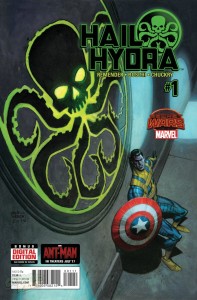 floating Celestial head above Battleworld (where did a Celestial come from if everybody’s in a universe created by Doom, and nothing else exists anywhere? Ehh… work with us here; it’s a cool-looking place for an orbiting city, anyway…). As with Captain Britain, the art helps the book considerably; Deodato has some of Davis’s careful realism, and ability to draw many different characters well. Hail Hydra is about an area of Battleworld ruled by Arnim Zola (in partnership with, duh, Hydra), but then Ian Rogers (Zola’s son who was reformed and adopted by Captain America, Steve Rogers, in the “regular” Marvel universe during writer Remender’s tenure on Cap’s book — aren’t you glad I know all of this stuff, so you don’t have to?) shows up and starts fomenting rebellion, not realizing he’s in an alternate timeline. This is a typically twisty Remender plot, and is OK — and more than that if you enjoyed that era of Captain
floating Celestial head above Battleworld (where did a Celestial come from if everybody’s in a universe created by Doom, and nothing else exists anywhere? Ehh… work with us here; it’s a cool-looking place for an orbiting city, anyway…). As with Captain Britain, the art helps the book considerably; Deodato has some of Davis’s careful realism, and ability to draw many different characters well. Hail Hydra is about an area of Battleworld ruled by Arnim Zola (in partnership with, duh, Hydra), but then Ian Rogers (Zola’s son who was reformed and adopted by Captain America, Steve Rogers, in the “regular” Marvel universe during writer Remender’s tenure on Cap’s book — aren’t you glad I know all of this stuff, so you don’t have to?) shows up and starts fomenting rebellion, not realizing he’s in an alternate timeline. This is a typically twisty Remender plot, and is OK — and more than that if you enjoyed that era of Captain 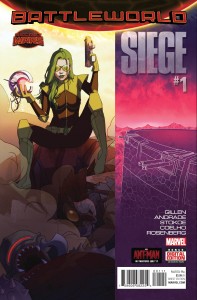 America. Siege, finally, is Abigail Brand manning the Shield, the wall that circles the bottom of Battleworld and keeps out the Ultrons, zombies and similar menaces — so it really has nothing to do with the Siege mini-series whose name it’s appropriating. That’s fine, though, because instead of focusing on one small timeline or section, it’s covering the whole planet, and seems to be more tied in to the main Secret Wars series than the other books — it name-checks Thanos, for example. It also offers an intriguing explanation of the Shield Wall — it’s actually a vast mutated version of Ben Grimm, The Thing, with Doom presumably finding a use for his old enemy in the same way that Johnny Storm is now Battleworld’s eternally-flaming sun. Huh. Gillen’s always dependable on the writing, and Andrade’s got an interesting, impressionistic style, so this turns out to be one of the better tie-ins of the bunch.
America. Siege, finally, is Abigail Brand manning the Shield, the wall that circles the bottom of Battleworld and keeps out the Ultrons, zombies and similar menaces — so it really has nothing to do with the Siege mini-series whose name it’s appropriating. That’s fine, though, because instead of focusing on one small timeline or section, it’s covering the whole planet, and seems to be more tied in to the main Secret Wars series than the other books — it name-checks Thanos, for example. It also offers an intriguing explanation of the Shield Wall — it’s actually a vast mutated version of Ben Grimm, The Thing, with Doom presumably finding a use for his old enemy in the same way that Johnny Storm is now Battleworld’s eternally-flaming sun. Huh. Gillen’s always dependable on the writing, and Andrade’s got an interesting, impressionistic style, so this turns out to be one of the better tie-ins of the bunch.
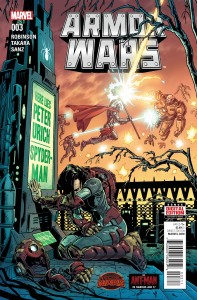 Secret Wars: Armor Wars #3 (of 5) — Writer: James Robinson; Art: Marcio Takara; Colors: Esther Sanz
Secret Wars: Armor Wars #3 (of 5) — Writer: James Robinson; Art: Marcio Takara; Colors: Esther Sanz
Secret Wars: Captain Marvel and the Carol Corps #2 (of 4) — Writers: Kelly Sue DeConnick and Kelly Thompson; Art/Colors: David Lopez
Secret Wars: Inhumans: Attilan Rising #3 (of 4) — Writer: Charles Soule; Pencils: John Timms; Inks: Roberto Poggi; Colors: Frank D’Armata
 Secret Wars: Korvac Saga #2 (of 4) — Writer: Dan Abnett; Art: Otto Schmidt; Colors: Cris Peter
Secret Wars: Korvac Saga #2 (of 4) — Writer: Dan Abnett; Art: Otto Schmidt; Colors: Cris Peter
Secret Wars: Planet Hulk #3 (of 5) — Writer: Sam Humphries; Art: Marc Laming; Colors: Jordan Boyd
Secret Wars: Battleworld #3 (of 4) — (First Story): Writer: Ivan Brandon; Art: Aaron Conley; Colors: Ryan  Browne; (Second Story): Writer: Ryan Ferrier; Art/Colors: Logan Faerber
Browne; (Second Story): Writer: Ryan Ferrier; Art/Colors: Logan Faerber
Secret Wars: Where Monsters Dwell #3 (of 5) — Writer: Garth Ennis; Art: Russ Braun; Colors: Dono Sanchez Almara
Secret Wars: Years of Future Past #3 (of 5) — Writer: Marguerite Bennett; Art: Mike Norton; Colors: FCO  Plascencia
Plascencia
All the ongoing SW series: Armor Wars is about a city where all of the population is infected with a disease that requires them to wear Iron Man-like armor all the time; it also has both Tony and Arno Stark as rivals. I haven’t been a big fan of this one, feeling that the cartoony Takara art is a bad fit for all the tech — although he’s got a kind-of cool one-page sketchbook in the back describing how he came up with the character designs, and there’s  one good scene between Tony and Arno. Captain Marvel is like reading a regular issue of that title, with DeConnick and Lopez both on board; since that team is leaving the book before all the relaunches in the fall, this is worthwhile as their farewell to the characters, even if everyone’s a tad distorted from being on Battleworld. Inhumans has benefited from its unexpected plot, with a talking, James Bond-ish Black Bolt leading a rebellion against the Inhumans’ ruler, Medusa (whom, in this reality, he’s never met…?); it would have more attraction for me if I actually
one good scene between Tony and Arno. Captain Marvel is like reading a regular issue of that title, with DeConnick and Lopez both on board; since that team is leaving the book before all the relaunches in the fall, this is worthwhile as their farewell to the characters, even if everyone’s a tad distorted from being on Battleworld. Inhumans has benefited from its unexpected plot, with a talking, James Bond-ish Black Bolt leading a rebellion against the Inhumans’ ruler, Medusa (whom, in this reality, he’s never met…?); it would have more attraction for me if I actually 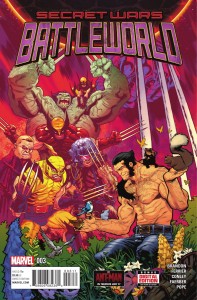 cared about any of the Inhumans. Korvac has had an exceedingly slow start, with the title character and his wife rulers of one section of Battleworld, aided by the classic ’60s/’70s version of the Guardians of the Galaxy, and their neighboring district being ruled by Simon Williams, Wonder Man, and a version of the Avengers. Halfway through, not much has happened, but the book’s last few pages suggest that Abnett, who’s adept with all of Marvel’s cosmic characters, has a plan that should up the pyrotechnics considerably in the last half of the series; let’s hope. Conversely, plenty happens in Planet
cared about any of the Inhumans. Korvac has had an exceedingly slow start, with the title character and his wife rulers of one section of Battleworld, aided by the classic ’60s/’70s version of the Guardians of the Galaxy, and their neighboring district being ruled by Simon Williams, Wonder Man, and a version of the Avengers. Halfway through, not much has happened, but the book’s last few pages suggest that Abnett, who’s adept with all of Marvel’s cosmic characters, has a plan that should up the pyrotechnics considerably in the last half of the series; let’s hope. Conversely, plenty happens in Planet 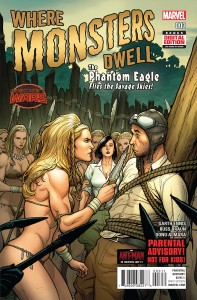 Hulk — it has Steve Rogers (well, a Steve Rogers) dressed as Conan the Barbarian, riding Devil Dinosaur through the gamma-ray-soaked “Greenland,” where everything is Hulked out, aided by the smart-scientist Hulk Doc Green — but it’s hard to care much about it, or to see where the rambling quest-for-Bucky story is going. You wouldn’t think Battleworld could get up much momentum, either, because it’s only got two ten-page stories, but they’re both self-contained, successful little efforts; the first, with a bunch of Wolverines interacting, is helped by the Conley art (he reminds me of Juan Jose Ryp, who drew him in the Wolverine: The Best There Is
Hulk — it has Steve Rogers (well, a Steve Rogers) dressed as Conan the Barbarian, riding Devil Dinosaur through the gamma-ray-soaked “Greenland,” where everything is Hulked out, aided by the smart-scientist Hulk Doc Green — but it’s hard to care much about it, or to see where the rambling quest-for-Bucky story is going. You wouldn’t think Battleworld could get up much momentum, either, because it’s only got two ten-page stories, but they’re both self-contained, successful little efforts; the first, with a bunch of Wolverines interacting, is helped by the Conley art (he reminds me of Juan Jose Ryp, who drew him in the Wolverine: The Best There Is 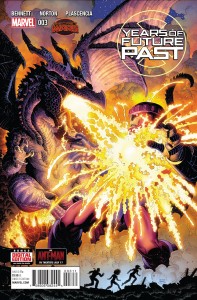 mini-series); the second is a Deadpool Western, complete with Moon Boy and Devil Dinosaur (that red-hued Marvel saurian seems to be getting around quite a bit on Battleworld…). Throw in a one-page coda involving Ant Man by, of all people, Paul Pope, and the result is a nice, easy-to-like package. So too for Where Monsters Dwell, which sees Garth Ennis and old-time collaborator Braun romping around the South Seas, with their clueless male protagonist encountering an island of warrior women, and wince-inducing hilarity ensuing. Finally, Years of Future Past is yet another X-Men alterna-book, involving the future Sentinel-concentration-camp timeline from Uncanny X-Men #s 141 and 142; as with most of these, it’s perfectly OK if you have fond memories of the originals, but less interesting if you don’t.
mini-series); the second is a Deadpool Western, complete with Moon Boy and Devil Dinosaur (that red-hued Marvel saurian seems to be getting around quite a bit on Battleworld…). Throw in a one-page coda involving Ant Man by, of all people, Paul Pope, and the result is a nice, easy-to-like package. So too for Where Monsters Dwell, which sees Garth Ennis and old-time collaborator Braun romping around the South Seas, with their clueless male protagonist encountering an island of warrior women, and wince-inducing hilarity ensuing. Finally, Years of Future Past is yet another X-Men alterna-book, involving the future Sentinel-concentration-camp timeline from Uncanny X-Men #s 141 and 142; as with most of these, it’s perfectly OK if you have fond memories of the originals, but less interesting if you don’t.
 Hawkeye #22 — Writer: Matt Fraction; Art: David Aja; Colors: Matt Hollingsworth
Hawkeye #22 — Writer: Matt Fraction; Art: David Aja; Colors: Matt Hollingsworth
Silver Surfer #13 — Writer: Dan Slott; Art: Michael Allred; Colors: Laura Allred
Ant-Man Annual #1 — Writer: Nick Spencer; Art: Brent Schoonover and Ramon Rosanas; Colors: Jordan Boyd
Three other Marvel books to round out the week — the 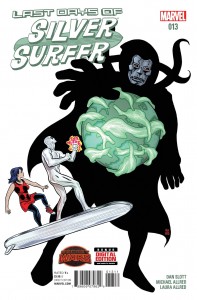 clear winner is Hawkeye #22, the long-awaited (as in, over a year, so long that the Hawkeye series after this one has already published three issues, with a fourth due next week…) finale to the Matt Fraction/David Aja run on the title. With thirty story pages, it manages to wrap up its confrontations and loose ends, leave its characters in just the places they deserve, and stick the landing nicely; it deserves to be remembered as a classic
clear winner is Hawkeye #22, the long-awaited (as in, over a year, so long that the Hawkeye series after this one has already published three issues, with a fourth due next week…) finale to the Matt Fraction/David Aja run on the title. With thirty story pages, it manages to wrap up its confrontations and loose ends, leave its characters in just the places they deserve, and stick the landing nicely; it deserves to be remembered as a classic 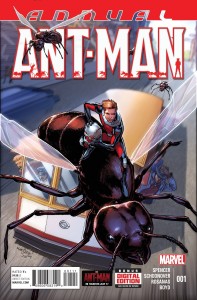 take on the Avengers bowman, and it’ll be fun to go back over the trade collections sometime, and read it in one sitting. Silver Surfer nears the end of its run, too, and it’s been a similarly-high-octane ride, with Slott’s surprisingly-affecting blend of humanism and cosmic sf giving Allred a perfect vehicle for his quirky, dazzling art. Ant-Man Annual, finally, is a stand-alone tale, also thirty pages, teaming up Hank Pym and Scott Lang against an old villain (in a flashback, since Pym is “dead” in current continuity), and also involving the Wasp and a new candidate to be Giant-Man; it’s an effective, and timely, souvenir for fans of the new movie.
take on the Avengers bowman, and it’ll be fun to go back over the trade collections sometime, and read it in one sitting. Silver Surfer nears the end of its run, too, and it’s been a similarly-high-octane ride, with Slott’s surprisingly-affecting blend of humanism and cosmic sf giving Allred a perfect vehicle for his quirky, dazzling art. Ant-Man Annual, finally, is a stand-alone tale, also thirty pages, teaming up Hank Pym and Scott Lang against an old villain (in a flashback, since Pym is “dead” in current continuity), and also involving the Wasp and a new candidate to be Giant-Man; it’s an effective, and timely, souvenir for fans of the new movie.
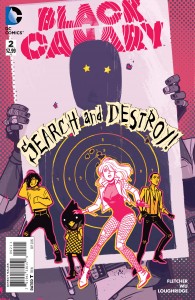 Black Canary #2 — Writer: Brenden Fletcher; Art: Annie Wu; Colors: Lee Loughridge
Black Canary #2 — Writer: Brenden Fletcher; Art: Annie Wu; Colors: Lee Loughridge
Doomed #2 — Writer: Scott Lobdell; Art: Javier Fernandez; Colors: Ulises Arreola
Doctor Fate #2 — Writer: Paul Levitz; Art: Sonny Liew; Colors: Lee Loughridge
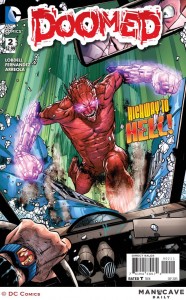 Green Lantern: Lost Army #2 — Writer: Cullen Bunn; Art/Colors: Jesus Saiz
Green Lantern: Lost Army #2 — Writer: Cullen Bunn; Art/Colors: Jesus Saiz
Martian Manhunter #2 — Writer: Rob Williams; Pencils: Eddy Barrows; Inks: Eder Ferreira; Colors: Gabe Eltaeb
Robin, Son of Batman #2 — Writer/Pencils: Patrick Gleason; Inks: Mick Gray; Colors: John Kalisz and Jeremy 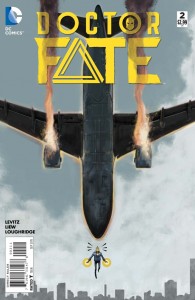 Cox
Cox
A hextet of DC second issues — Black Canary continues to be aimed squarely at the Batgirl readership, with Annie Wu’s sleek modernistic style adding energy to a story about Dinah as the reluctant head of an all-girl rock group, menaced by mysterious high-tech bad guys (with a last-panel reveal about one of them that’s a classic come-back-next-issue stinger). Doomed, about a teen infected with the Doomsday virus, which causes him to Hulk-out 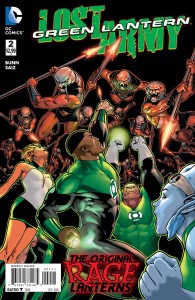 periodically, gives more information about its protagonist’s condition this time, but still is moving slowly: by the end of this second issue, he’s only transformed once, and he doesn’t even appear in six of the nineteen story pages here, with those being given over to an unusual interstellar bounty hunter who’s somehow tracking him. Lobdell, an old pro, knows how to string together subplots and give Fernandez interesting things to draw, but there doesn’t seem to be much of a spark here. Doctor Fate has more oomph, with
periodically, gives more information about its protagonist’s condition this time, but still is moving slowly: by the end of this second issue, he’s only transformed once, and he doesn’t even appear in six of the nineteen story pages here, with those being given over to an unusual interstellar bounty hunter who’s somehow tracking him. Lobdell, an old pro, knows how to string together subplots and give Fernandez interesting things to draw, but there doesn’t seem to be much of a spark here. Doctor Fate has more oomph, with 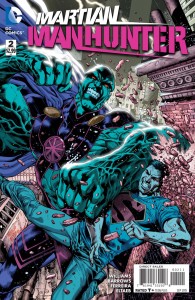 an even-more-seasoned writer, Paul Levitz, utilizing his secret weapon: artist Sonny Liew, whose plastic, attractive style is a good match for the book’s weird occult goings-on. Green Lantern: The Lost Army continues to be a down-the-middle Green Lantern Corps story, with John Stewart, Guy Gardner and others trying to survive after being stranded in a distant corner (and time period) of the multiverse, while Martian Manhunter offers a densely-written and dramatic story
an even-more-seasoned writer, Paul Levitz, utilizing his secret weapon: artist Sonny Liew, whose plastic, attractive style is a good match for the book’s weird occult goings-on. Green Lantern: The Lost Army continues to be a down-the-middle Green Lantern Corps story, with John Stewart, Guy Gardner and others trying to survive after being stranded in a distant corner (and time period) of the multiverse, while Martian Manhunter offers a densely-written and dramatic story 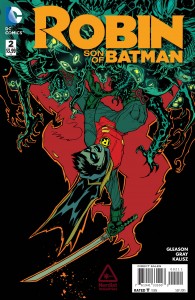 about J’onn J’onzz facing a Martian invasion of earth, which changes the way his Justice League colleagues, and he himself, see his place in the world. That leaves Robin, Son of Batman, whose title pretty much sums it up: Damian, with Bruce Wayne presumed dead, is traveling the world to right wrongs he committed during his time with his mother Talia, and become the hero his father wanted him to be. This is all on Gleason as both writer and artist, a rarity at DC, and so far he’s delivering a somewhat-above-average comic (better on the art than the writing, but give him time…).
about J’onn J’onzz facing a Martian invasion of earth, which changes the way his Justice League colleagues, and he himself, see his place in the world. That leaves Robin, Son of Batman, whose title pretty much sums it up: Damian, with Bruce Wayne presumed dead, is traveling the world to right wrongs he committed during his time with his mother Talia, and become the hero his father wanted him to be. This is all on Gleason as both writer and artist, a rarity at DC, and so far he’s delivering a somewhat-above-average comic (better on the art than the writing, but give him time…).
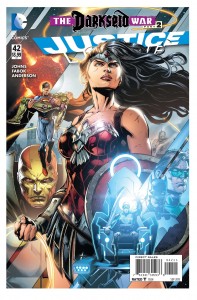 Justice League #42 — Writer: Geoff Johns; Art: Jason Fabok; Colors: Brad Anderson
Justice League #42 — Writer: Geoff Johns; Art: Jason Fabok; Colors: Brad Anderson
Secret Six #4 — Writer: Gail Simone; Art: Ken Lashley and Tom Derenick; Colors: Jason Wright
Two more DCs — Justice League is two issues into a huge Darkseid story, with Johns delivering his usual big-screen fireworks, and fan-friendly plotting (what would happen if Superman and Lex Luthor were stranded on Apokolips? What if Batman sat in Metron’s Mobius chair, and had 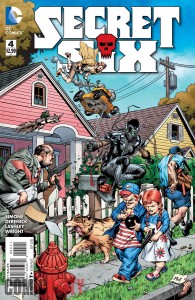 access to all the information in the multiverse?), and aided by Fabok’s solid, superhero-friendly art. Secret Six, meanwhile, operates on a much less cosmic scale, with its six mismatched bad-guy fugitives hiding out in the suburbs (they think, although there’s a traitor in their midst…), with the clash between their urban weirdness (and casual deadliness) and their sedate surroundings driving much of the humor. Simone also throws in some gifts to old-time readers, with the introduction of a couple of familiar characters to the mix — although apparently, in the New 52 universe, everyone’s relationships are different….
access to all the information in the multiverse?), and aided by Fabok’s solid, superhero-friendly art. Secret Six, meanwhile, operates on a much less cosmic scale, with its six mismatched bad-guy fugitives hiding out in the suburbs (they think, although there’s a traitor in their midst…), with the clash between their urban weirdness (and casual deadliness) and their sedate surroundings driving much of the humor. Simone also throws in some gifts to old-time readers, with the introduction of a couple of familiar characters to the mix — although apparently, in the New 52 universe, everyone’s relationships are different….
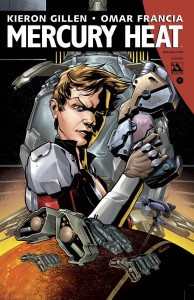 Mercury Heat #1 — Writer: Kieron Gillen; Art: Omar Francia; Colors: Digikore Studios
Mercury Heat #1 — Writer: Kieron Gillen; Art: Omar Francia; Colors: Digikore Studios
Empty Zone #2 — Writer/Art: Jason Shawn Alwxander; Colors: Luis Nct
One first and one second issue from the indy books: Mercury Heat is a new sf series from Kieron Gillen, about a tough woman police officer on the title planet (female cops in space is becoming a robust genre right now, with The Fuse and Copperhead both critical favorites), and has his typical combination of startling ideas, well-thought-out 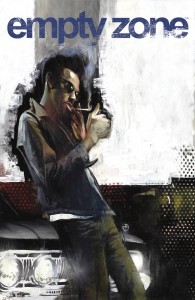 plotting and subtle-but-clear characterization. Empty Zone is also sf, set about a hundred years from now in one of those grungy-but-high-tech Blade Runner futures where everyone’s got mechanical enhancements; it’s another book with a tough-girl female lead, a data miner/bounty hunter who’s having hallucinations, apparently caused by the spirits of people who’ve been killed and had their bodies made into some kind of mechanical zombies. This is another book that’s using a slow build, so that even two issues in the main ideas aren’t all clear yet, but Anderson’s got enough interesting ideas and eye-catching art for this to have a good shot at being around for a while.
plotting and subtle-but-clear characterization. Empty Zone is also sf, set about a hundred years from now in one of those grungy-but-high-tech Blade Runner futures where everyone’s got mechanical enhancements; it’s another book with a tough-girl female lead, a data miner/bounty hunter who’s having hallucinations, apparently caused by the spirits of people who’ve been killed and had their bodies made into some kind of mechanical zombies. This is another book that’s using a slow build, so that even two issues in the main ideas aren’t all clear yet, but Anderson’s got enough interesting ideas and eye-catching art for this to have a good shot at being around for a while.
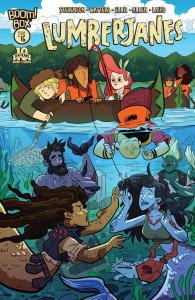 Lumberjanes #16 — Writers: Noelle Stevenson and Shannon Watters; Art: Brooke Allen; Colors: Maarta Laiho
Lumberjanes #16 — Writers: Noelle Stevenson and Shannon Watters; Art: Brooke Allen; Colors: Maarta Laiho
Groo: Friends and Foes #7 (of 12) — Creator/Art: Sergio Aragones; Words: Mark Evanier; Colors: Tom Luth
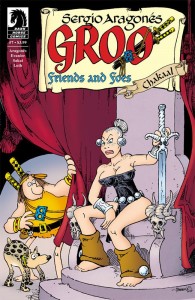 Usagi Yojimbo #147 — Writer/Artist: Stan Sakai
Usagi Yojimbo #147 — Writer/Artist: Stan Sakai
Crossed Plus One Hundred #6 — Writer: Alan Moore; Art: Gabriel Andrade; Colors: Digikore Studios
Rachel Rising #35 — Writer/Artist: Terry Moore
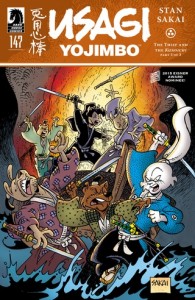 Trees #11 — Writer: Warren Ellis; Art/Colors: Jason Howard
Trees #11 — Writer: Warren Ellis; Art/Colors: Jason Howard
Astro City #25 — Writer: Kurt Busiek; Art: Jesus Merino; Colors: Wendy Broome and Alex Sinclair
Gold Digger #223 — Writer/Artist: Fred Perry
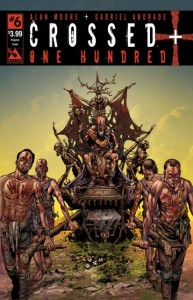 The ongoing indy series. Lumberjanes, Groo and Usagi are all great comics for all ages, with colorful, cartoony art and appealing characters to attract kids, and enough sophisticated plotting and high-quality production to keep adults interested, too. Lumberjanes was a deserved breakout hit last year, and its tale of girls at a summer scout camp in a mysterious woods continues to fascinate, as it expands its
The ongoing indy series. Lumberjanes, Groo and Usagi are all great comics for all ages, with colorful, cartoony art and appealing characters to attract kids, and enough sophisticated plotting and high-quality production to keep adults interested, too. Lumberjanes was a deserved breakout hit last year, and its tale of girls at a summer scout camp in a mysterious woods continues to fascinate, as it expands its 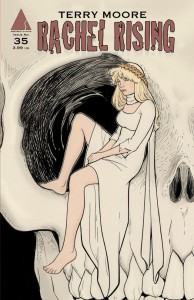 mythology and the characters’ relationships. Groo and Usagi have been around forever; if you’re a comics fan and you’ve never given these books a a try, you’re missing work by some of the top creators in the field. Crossed Plus One Hundred is definitely not for kids (as if you had to be told that), and is typical Moore horror — the slow build to a horrible revelation that leaves its main characters devastated; it’s got a masterful structure and casual brilliance in some of its future extrapolations, but
mythology and the characters’ relationships. Groo and Usagi have been around forever; if you’re a comics fan and you’ve never given these books a a try, you’re missing work by some of the top creators in the field. Crossed Plus One Hundred is definitely not for kids (as if you had to be told that), and is typical Moore horror — the slow build to a horrible revelation that leaves its main characters devastated; it’s got a masterful structure and casual brilliance in some of its future extrapolations, but  shouldn’t be read if you’re prone to depression. Rachel Rising is horror, too, but that other Moore, Terry, is more optimistic in his storytelling, and leavens his gore and evil doings with humor and a light at the end of the tunnel; whether that makes him a better creator is a good question, but it definitely leaves his readers feeling happier. Trees is prime Warren Ellis (when was the last time he spent eleven issues on the same title…?), with a worldwide scope and a lot of moving parts; this installment focuses on
shouldn’t be read if you’re prone to depression. Rachel Rising is horror, too, but that other Moore, Terry, is more optimistic in his storytelling, and leavens his gore and evil doings with humor and a light at the end of the tunnel; whether that makes him a better creator is a good question, but it definitely leaves his readers feeling happier. Trees is prime Warren Ellis (when was the last time he spent eleven issues on the same title…?), with a worldwide scope and a lot of moving parts; this installment focuses on 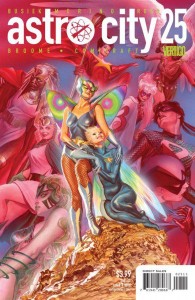 events in Scotland and New York City, with a payoff that will only make sense if you’ve been reading the whole thing so far — although even new readers will be impressed by Howard’s art; he reminds me of the Brazilian brothers, Moon and Ba, with a precise, clean style that’s somehow also very human. Astro City does offer a good jumping-on point, with a done-in-one story using guest artist Merino; it’s another book that, if you’ve never tried it, you really owe it to
events in Scotland and New York City, with a payoff that will only make sense if you’ve been reading the whole thing so far — although even new readers will be impressed by Howard’s art; he reminds me of the Brazilian brothers, Moon and Ba, with a precise, clean style that’s somehow also very human. Astro City does offer a good jumping-on point, with a done-in-one story using guest artist Merino; it’s another book that, if you’ve never tried it, you really owe it to 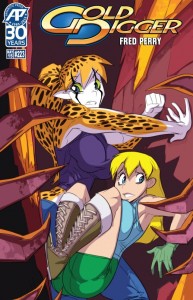 yourself to pick up, especially if you like well-thought-out, character-rich and imaginative superhero stuff. Finally, Gold Digger is Fred Perry’s uniquely-personal take on a woman professor who has Indiana Jones-type adventures across the multiverse. It’s been around for an astonishing 25 years, and has accreted a sprawling mythology — and yet, Perry’s good about making each issue a self-contained, satisfying story for new fans, so it’s yet another comic that’s worth a look: use summer’s extra free time to try it, and see if his bright manga style and clever science-rich plotting don’t bring you back for more.
yourself to pick up, especially if you like well-thought-out, character-rich and imaginative superhero stuff. Finally, Gold Digger is Fred Perry’s uniquely-personal take on a woman professor who has Indiana Jones-type adventures across the multiverse. It’s been around for an astonishing 25 years, and has accreted a sprawling mythology — and yet, Perry’s good about making each issue a self-contained, satisfying story for new fans, so it’s yet another comic that’s worth a look: use summer’s extra free time to try it, and see if his bright manga style and clever science-rich plotting don’t bring you back for more.



